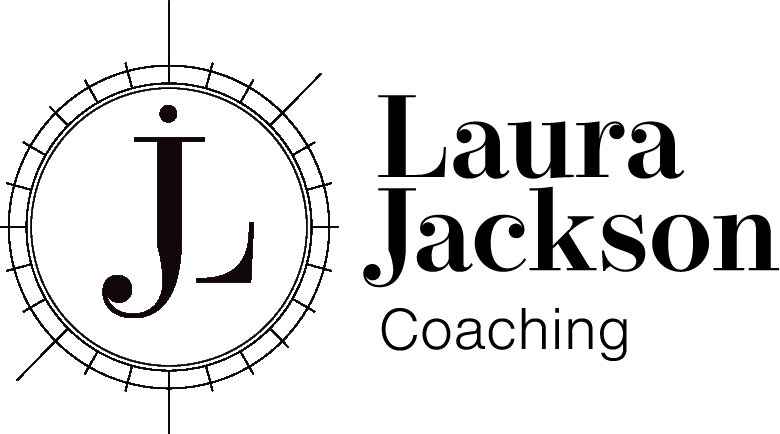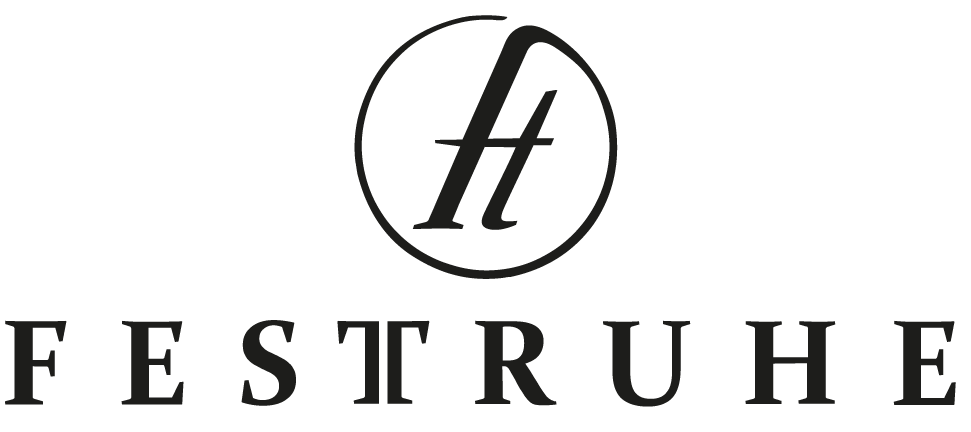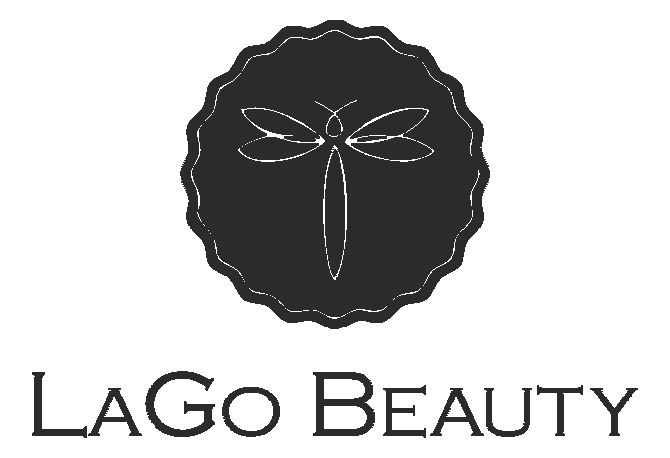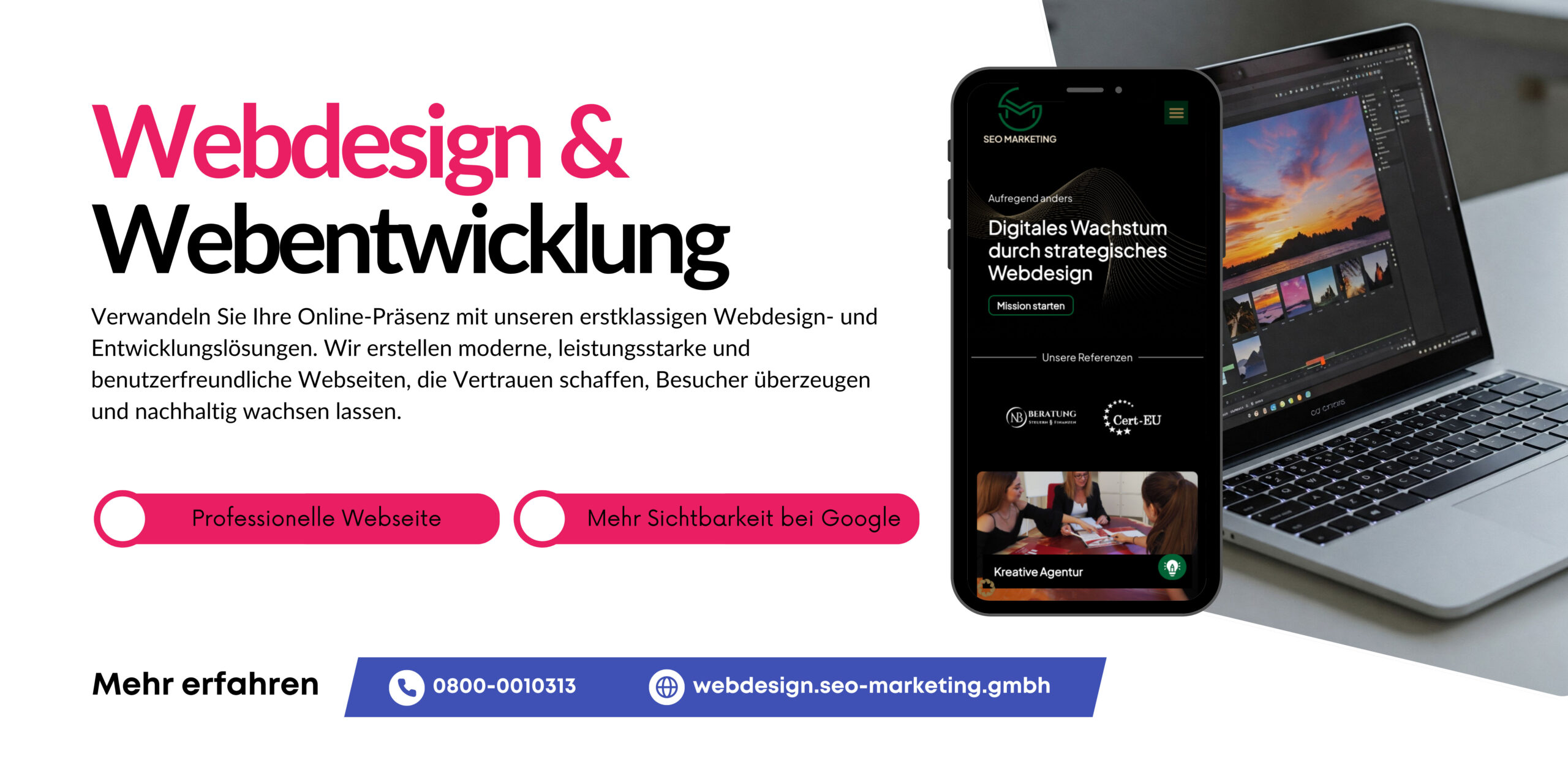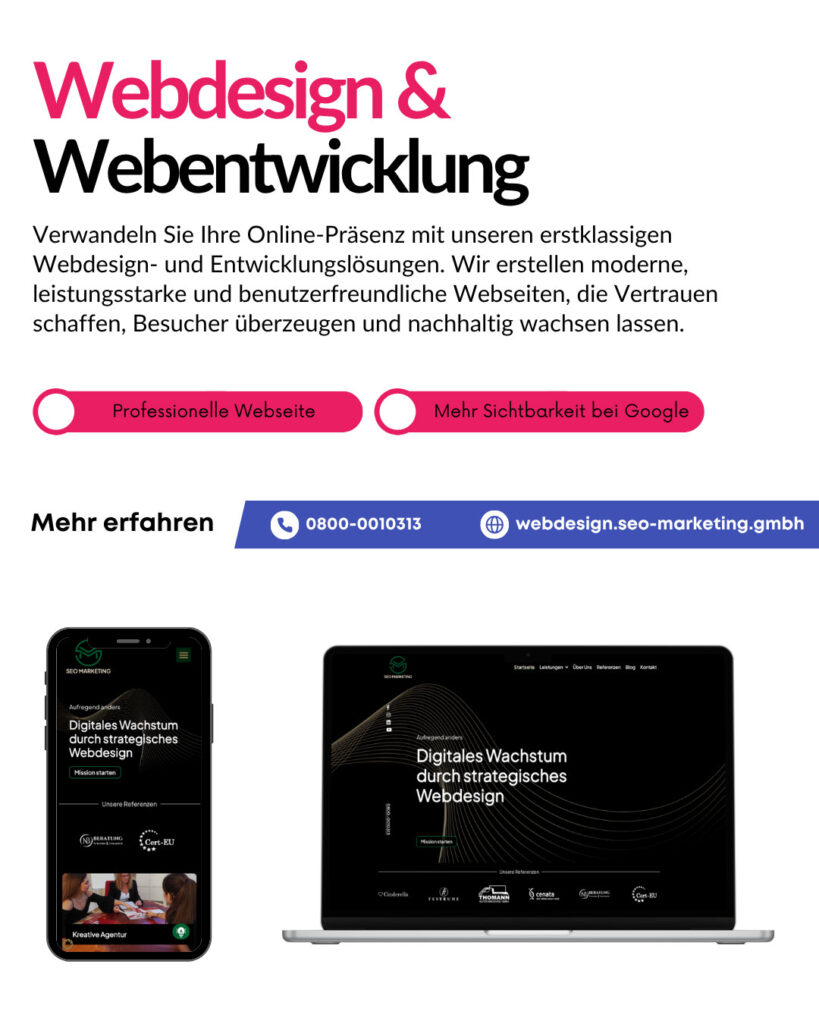SEO – Web design – Google Ads – Social media
Web design agency: Websites that win customers
Our strategy for professional web design that strengthens your brand and delivers measurable results.
Individual marketing solutions
Graphic design
We create modern designs that visually strengthen your brand, create trust and are remembered for a long time.
Website creation
We create modern, search engine optimized websites that convince, create trust and generate leads.
Online stores
We develop sales-boosting online stores that present your products in the best possible way and lead customers directly to a purchase.
Online marketing consulting
We analyze your marketing holistically, develop clear strategies and sustainably increase your online presence.
Accessibility
We check and optimize your website according to BFSG standards - for legal certainty, greater reach and better SEO.
Certification
We check your website according to over 100 SEO criteria and certify it for top performance and maximum visibility.
Domain & Hosting
We take care of domain, hosting and maintenance - everything from a single source, secure, fast and professionally managed.
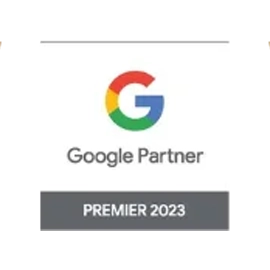

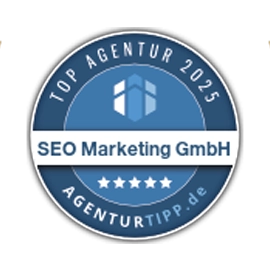

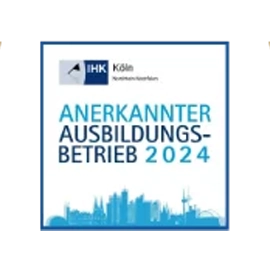
Web design agency: Professional websites that really deliver results
Do you know this? Your website is online, but the phone remains silent and hardly any inquiries come in via the contact form. Many entrepreneurs have the feeling that their website is simply not performing as well as they had hoped. This is often due to an outdated design, confusing navigation or the fact that the site doesn’t work properly on a smartphone. The result is always the same: potential customers are frustrated and switch to the competition.
This is exactly where we come in as your web design agency. We specialize in building websites that not only look good, but above all pursue a clear goal: To make your company more successful. We develop a professional website for you that clearly communicates your strengths, creates trust with your customers and generates inquiries.






More than just a nice look: a website that works for you
In today’s market, your website is often the first point of contact with new customers. Within a few seconds, visitors decide whether they trust your company and stay or leave the site again. An unprofessional website can lead to the quality of your work being underestimated. So it’s about much more than just design – it’s about credibility and taking advantage of business opportunities.
Our task as agency for web design is to create a website that impresses your visitors. We make sure that all important information is easy to find, that your offers are presented clearly and that contacting you is as easy as possible. We build a website that reflects your professionalism and encourages visitors to take the next step and contact you.
A good website is not an expense, but an investment that pays off
The question “What does a professional website cost?” is important, but the more important question is: What does it cost you to keep losing customers with a bad website? Every inquiry you don’t receive is lost revenue. A well-designed website is a long-term investment in your business that will pay for itself in new customers and a stronger brand image.
More qualified customer inquiries:
We make sure that your website actively invites visitors to get in touch with you. With clear user guidance, understandable content and clearly visible contact options, we make it easy for interested parties to make an inquiry. The goal is that your inbox is regularly filled with inquiries from people who are looking for exactly what you offer.
Build trust and appear professional:
A modern website shows that you move with the times and value quality. A clean, uncluttered design and high-quality content convey competence and create trust. When you have us create a professional website from uswe make sure that your company looks just as competent and reliable online as it does offline.
A solid technical basis for the future:
A website must run smoothly in the background. We attach great importance to fast loading times, clean programming and optimal display on all devices – from large monitors to small smartphones. This stable technical foundation is not only crucial for visitor satisfaction, but also an important prerequisite for a good Google ranking.
Analyze your website for free – more visibility now!
Have your website analyzed free of charge and discover optimization potential immediately. Get a quick SEO check with clear tips for better rankings, more visibility and more customers - free of charge, professionally and without obligation.
Our process: clear, understandable and based on partnership
We believe in transparency and close cooperation. That’s why we keep you informed at every step of the process.
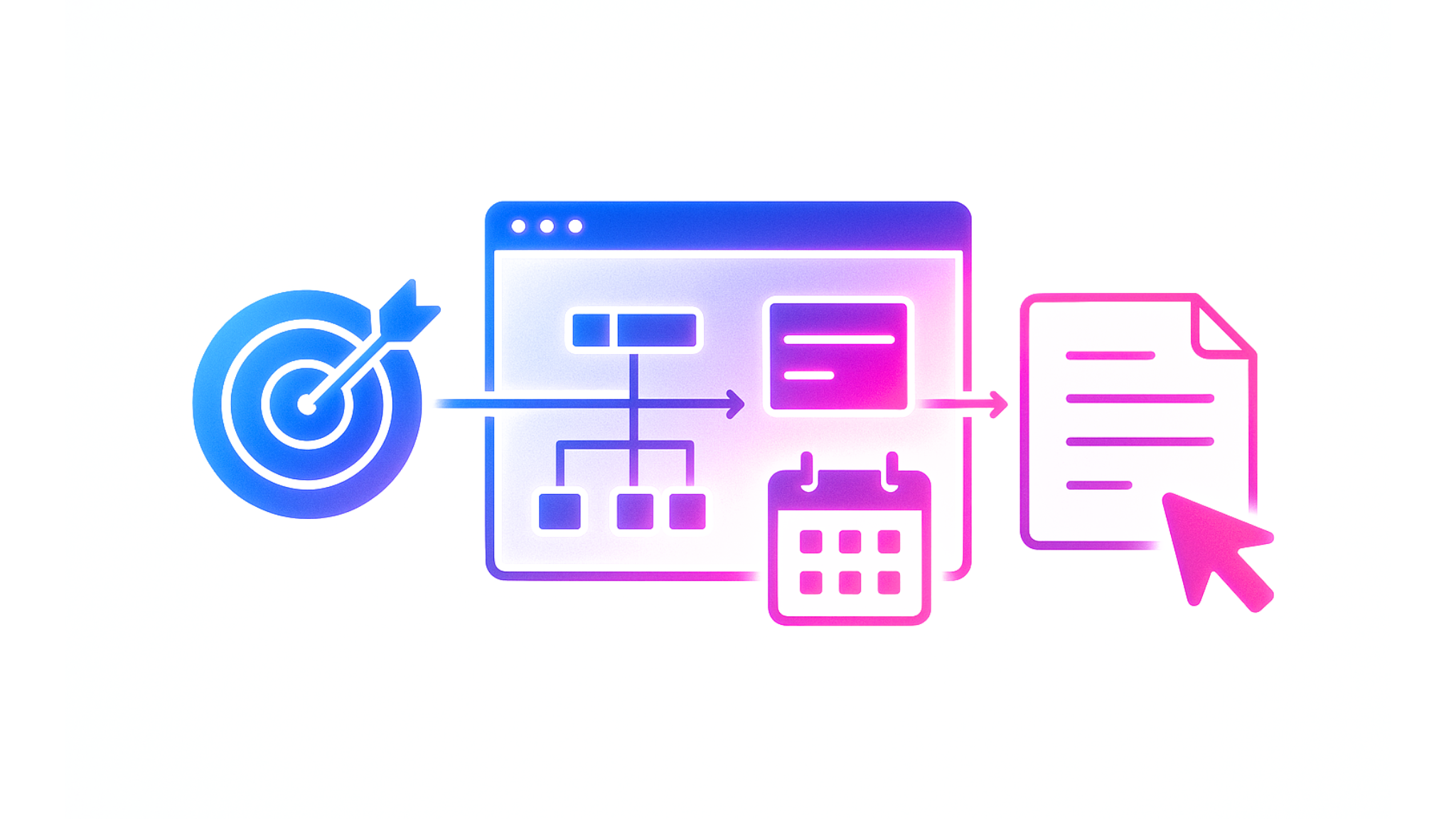
Listen & Plan (The Strategy):
It always starts with your goal. In a detailed discussion, we clarify what you want to achieve with your new website and who your customers are. On this basis, we develop a clear plan for the structure and content of the site.

Draft & Design (The Design):
Our web designers create an initial visual design for your new website. We discuss this design with you and adapt it until it meets your expectations 100% and presents your brand in the best possible way.
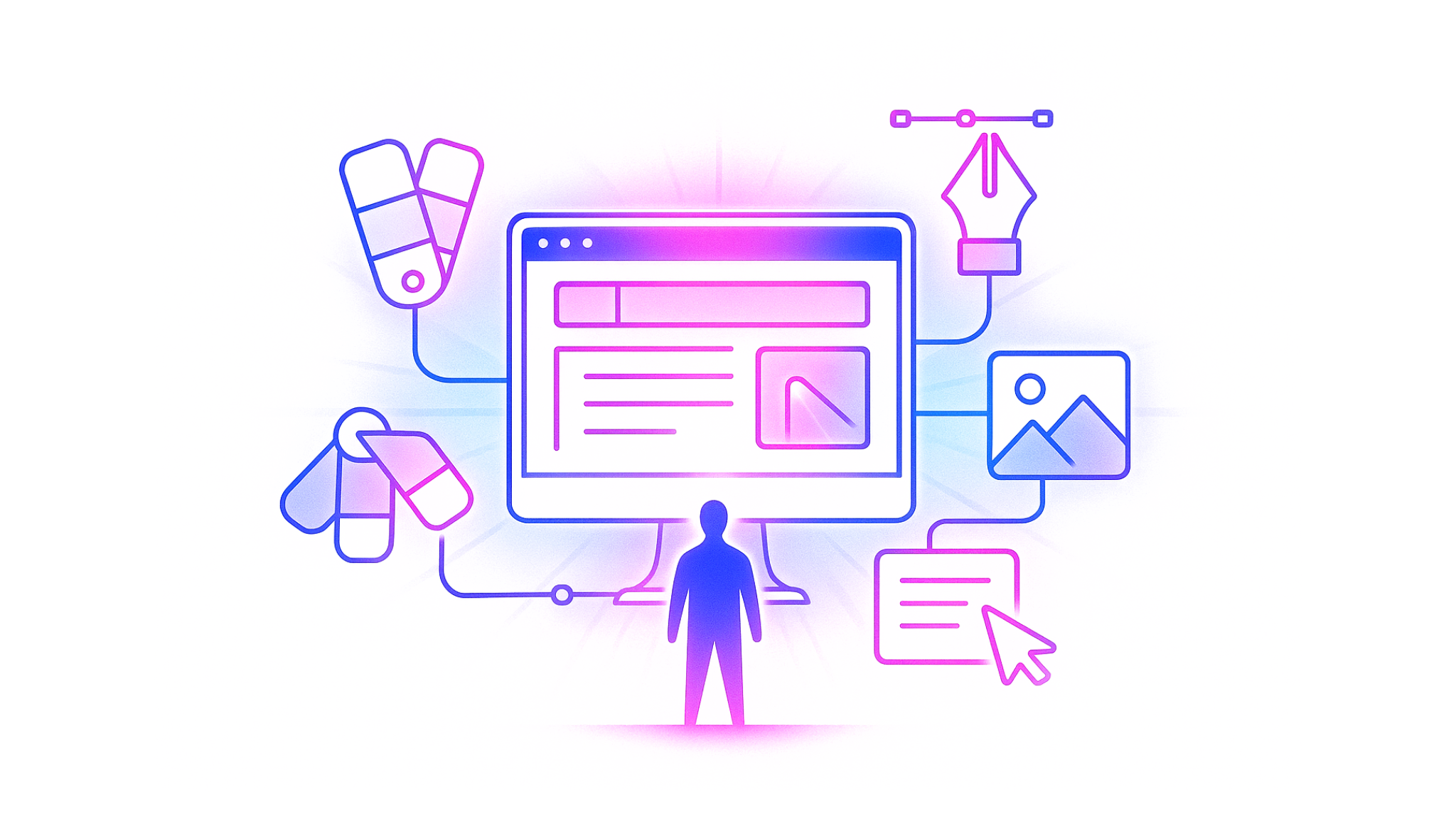

Programming & implementation (the technology):
As soon as the design is finalized, our developers implement it technically. We program a clean, fast and secure website and integrate a system (CMS) with which you can easily change texts or images yourself later on.

Test & Start (The live course):
Before your new website goes online, we test all functions extensively on various devices and browsers. We ensure a smooth launch and make sure that everything works perfectly right from the start.

Are you ready for a website that really helps you?
Stop settling for an outdated or ineffective website. It’s time for a professional website that represents your company properly and helps you to continuously attract new customers.
Let’s talk about how we can achieve your goals together in a free initial consultation. We look forward to hearing from you.
Frequently asked questions (FAQ)
What does a professional website cost?
The cost of a professional website depends heavily on the scope and the desired functions. A simple digital business card is cheaper than a complex online store with a connection to a merchandise management system. Important factors that influence the price are
Design: Will a template be customized or a completely individual design created?
Number of pages: How many subpages are needed?
Functions: Are special tools such as a booking system, a member area or configurators required?
Content creation: Are texts and images supplied by you or created by us?
As a reputable web design agency, we do not offer all-inclusive prices, as every project is unique. After a free initial consultation, you will receive a transparent and detailed quote from us that is tailored precisely to your goals.
How long does it take to create a new website?
On average, it takes between four and twelve weeks to create a website. Here too, the scope of the project is the decisive factor. A smaller website can be realized more quickly than an extensive company website. The process comprises several phases: Strategy and planning, design draft, technical implementation, content insertion and final testing. Close collaboration and quick feedback from your side can speed up the process considerably.
What should you look out for when choosing a web design agency?
Choosing the right agency is crucial to the success of your project. Pay attention to the following points:
Portfolio: Take a look at the agency’s previous work. Does the style meet your expectations and are there references in your industry?
Process: Does the agency explain its work process clearly and comprehensibly? A structured process from strategy to launch is a sign of professionalism.
Understanding: Does the agency take the time to understand your business model and goals, or are they just trying to sell you a quick fix?
Expertise: In addition to web design, does the agency also offer knowledge in areas such as SEO (search engine optimization) and conversion optimization? A modern website must also be found and convert visitors into customers.
Why is a professional website important for my company?
Today, a professional website is more than just a digital business card – it is your most important tool for customer acquisition. It works for you 24/7 and is often the first impression potential customers get of your company. The main advantages are:
Credibility and trust: A modern, flawless design signals professionalism and immediately creates trust.
More customer inquiries: Through clear user guidance and targeted calls to action, a good website converts visitors into valuable leads.
Visibility on Google: A technically clean website that is optimized for search engines is easier to find and gives you an advantage over the competition.
Competitive advantage: While your competitors rely on outdated websites, you can position yourself as a modern and customer-oriented provider with a professional presence.
Learn more
Web design – SEO marketing
Our appealing and user-friendly websites leave an impression. With creative solutions and professional expertise, SEO Marketing GmbH offers comprehensive support for your website. Together we clarify your wishes and requirements and then present you with a concept that is not only appealing to customers, but also embodies the image and values of your company. With appealing designs and captivating texts, your customers will become fans in no time at all. Whether it’s a website relaunch or a completely new website: SEO Marketing GmbH’s individual websites will be remembered!
Creative design
First impressions count! This also applies to your website. Creative web design sets you apart from the competition and increases the recognition value of your company. User-friendly interfaces also reduce the bounce rate.
High quality texts
Users generally stay longer on websites with interesting and informative texts. Therefore, high-quality texts are essential for a successful website. Regular content updates keep your website up-to-date and relevant!
Individual style guide
You will receive an individual style guide from our
designers that reflects you and your company.
This provides the basis for your website, but is also suitable
for many other purposes. With
you can create flyers, advertising material and more in no time at all
!
Individual concepts
What image do you want your site to convey? Which target group do you want to reach? What content and functions do you need on your website? Your personal contact will clarify these and other questions together with you. We will create a concept for you that not only looks appealing, but also meets your technical requirements. Style guides, wireframes and layouts are created in consultation with you. This ensures that your website reflects your company’s image in the best possible way.
Simultaneous SEO optimization
What good is the most beautiful website if it can’t be found by your customers? Your new website will be customized from the ground up to meet the requirements of search engines such as Google and others. This makes it easy to appear in the top search results of Google and co. This is achieved primarily through targeted keyword research, fast loading times and easy navigation. With an SEO-optimized website, your new site is not only user-friendly and aesthetically pleasing, it will also be found by your customers!
Mobile First
More and more people are using mobile devices to browse the internet. It is therefore important that your website is adapted to all screen sizes. Responsive web design guarantees an optimal user experience, whether on a computer, laptop, tablet or smartphone. Your new website is adapted to mobile devices from the ground up and adapts individually to the screen size or browser window. So every user really does have the best possible experience on your website.
Your website launch
Whether you would like to have a new website created or your current one no longer meets your requirements – with the individual designs, appealing texts and comprehensive support, including domain and hosting, no wish remains unfulfilled Let SEO Marketing GmbH advise you on your new website free of charge and without obligation!
Individual web design
- High rankings, thanks to professional optimization
- Can be used on any device thanks to responsive web design
- Individual designs, tailored to your company
- Aesthetically and technically modern websites
Holistic marketing support
- Detailed marketing
advice - Holistic strategies
for your company - Long-term
successes - One contact for all concerns
How can accessibility be incorporated into web design to reach a larger user base?
Considering accessibility in web design is crucial to ensure that your website is accessible to all users, regardless of their abilities or limitations. Here are some key measures to ensure accessibility in web design and reach a wider user base:
Structured and well thought-out navigation: Clear and intuitive navigation makes it easier for all users to find their way around your website. Use a consistent navigation structure with meaningful links and headings to improve usability for everyone.
Use semantic HTML elements: Use semantic HTML elements such as headings (h1-h6), lists, paragraphs and links to make the structure of your website clear and understandable. Semantic code also helps screen readers to read the content correctly and makes navigation easier for users with visual impairments.
Alternative texts for images: Describe all images on your website with concise and meaningful alternative texts (alt tags) so that users with visual impairments can understand the content. Alternative texts are read aloud by screen readers and are also useful if images cannot be loaded.
Color contrasts and legibility: Ensure sufficient color contrasts and good legibility of text to ensure that your content is easy to read for all users, including people with visual impairments or color vision deficiencies.
Keyboard accessibility: Make sure that all interactions on your website can also be carried out using the keyboard without having to rely on a mouse or touchpad. This enables users with motor impairments to operate your website without any problems.
Avoid flashing and flickering: Avoid flashing or flickering elements, as these can trigger seizures or impair concentration in some users. If animations are used, offer the option of deactivating them.
Responsive design and scalability: Design your website responsively so that it is easy to read and use on different devices and screen sizes. Make sure that the font sizes are adjustable so that users with visual impairments can enlarge the text as required.
Test with assistive technologies: Test your website regularly with assistive technologies such as screen readers, keyboard navigation and color filters to ensure it is accessible to all users. Also conduct usability tests with users to get feedback and identify problems.
By implementing these measures, you can ensure that your website is accessible to a wider user base and provides an inclusive online experience that caters to all users equally. This not only contributes to accessibility, but can also improve your reach and credibility.
How important is search engine optimization (SEO) when designing a website?
Search engine optimization (SEO) is crucial when designing a website as it helps to improve the visibility of the website in search engine results and thus attract more organic traffic. Here are some reasons why SEO is important when designing a website:
Increased visibility and discoverability: A website that is optimized for relevant search terms will appear higher in search engine results, resulting in increased visibility and discoverability. This means that potential visitors are more likely to come across your website when searching for products, services or information that you offer.
Qualified traffic: Through targeted SEO measures, you can drive qualified traffic to your website by ensuring that your content matches the needs and intentions of your target group. By using relevant keywords and providing high-quality content, you can attract users who are already interested in what you have to offer.
Improved user experience: Many aspects of SEO, such as fast loading times, user-friendly navigation and high-quality content, also contribute to improving the user experience. A well-optimized website provides a smooth and enjoyable browsing experience, which in turn promotes user satisfaction and retention.
Competitive advantage: In many industries, competition for attention and traffic to websites is fierce. An effective SEO strategy can give you a competitive advantage by positioning your website ahead of others in search engine results and encouraging potential customers to visit your website.
Long-term results: While paid advertising can deliver short-term results, SEO offers long-term benefits. A well-optimized website can maintain a good ranking in search engine results over the long term, resulting in a steady stream of organic visitors without incurring ongoing advertising costs.
Measurable results: With the help of analytics tools like Google Analytics, you can accurately track and measure the performance of your website. You can see how your SEO efforts are impacting traffic, conversion rates, dwell time and other key metrics and adjust your strategy accordingly.
Overall, SEO is an integral part of website design and should be considered from the very beginning. A well-optimized website is not only better for search engines, but also provides a better user experience and can contribute to your business success in the long run.
How can you develop a responsive web design that works well on different devices?
Developing a responsive web design that works well on different devices requires careful planning, design and implementation. Here are some best practices for developing a responsive web design:
Mobile First Approach: Start by designing and developing your website for mobile devices and then scale to larger screen sizes such as tablets and desktops. This approach ensures that your website works well on small screens and then adapts to larger screens.
Fluid grid layouts: Use fluid grid layouts and flexible units such as percentages or REM units instead of fixed pixel values. This allows the content of the website to adapt dynamically to the screen size of the device and enables a consistent user experience on different devices.
Media Queries: Use media queries to adjust the layout, font size, colors and other design elements based on the screen width and height of the device. Media queries allow you to set specific style rules for different screen sizes, ensuring that your website looks and works well on all devices.
Flexible images and media: Use CSS rules such as “max-width: 100%;” for images and other media content to ensure that they automatically adapt to the width of the display area. This prevents images from being cut off or distorted on small screens.
Touchscreen optimization: Make sure that all interactions and navigation elements are also suitable for touchscreen devices such as smartphones and tablets. Enlarge buttons and links to make them easier to operate with your fingers and avoid hover effects that do not work on touchscreens.
Test on different devices: Test your website on a variety of devices and screen sizes to make sure it works well on all of them. Use emulators, simulators and real devices to ensure your website is consistent across all platforms and browsers.
Performance optimization: Optimize the loading time of your website by minimizing the file size of images and other resources, using caching and implementing other best practices to improve performance. A fast load time is critical to your website’s user experience and SEO.
By considering these best practices for developing a responsive web design, you can ensure that your website works well on all devices and screen sizes and provides an optimal user experience.
The importance of web design for search engine optimization (SEO)
Web design plays a crucial role in search engine optimization (SEO), as it contributes significantly to how well a website is understood and rated by search engines such as Google. Search engine algorithms are becoming ever more sophisticated and increasingly take into account not only the content of a website, but also its structure, speed and user experience.
An important aspect of web design in the context of SEO is the structuring and organization of content. A clear and logical page structure makes it easier for search engines to understand the hierarchy of a website and to recognize the importance of individual pages and topics. This helps to ensure that relevant content is indexed appropriately by search engines and displayed in search results.
In addition, the loading time of a website plays a decisive role in search engine rankings. Fast web design that relies on efficient programming and optimization of image and file size not only improves the user experience, but is also preferred by search engines. Slow loading times, on the other hand, can lead to a higher bounce rate and have a negative impact on the ranking of a website.
User experience (UX) is another important factor that web designers need to consider in terms of SEO. A user-friendly website that is easy to navigate and has an appealing design increases the likelihood that visitors will stay on the site longer and visit more pages. This signals to search engines that the website offers high-quality content and therefore helps to improve rankings.
Another important aspect is the responsiveness of a website. With the increasing use of mobile devices to access the internet, it is essential that a website is displayed optimally on different screen sizes and devices. Search engines such as Google favor responsive websites and often reward them with a better ranking in search results.
In addition to these technical aspects, the visual design of a website also plays a role in SEO. High-quality graphics, appealing images and an aesthetically pleasing design help to increase visitor engagement and can have a positive effect on the ranking.
Overall, web design is a crucial factor for search engine optimization. By integrating the principles of SEO into their design and developing a website that is technically sound, user-friendly and visually appealing, web designers can help the website to be found better in search results and generate more traffic.
Trends in modern web design: What is important today?
In the fast-paced world of the internet, it is essential to keep up with the latest trends in web design to create a modern and engaging website. So what are the current trends that are particularly important in modern web design today?
A significant trend is the use of minimalist design and clear layouts. Less is often more, and many websites rely on simple, uncluttered designs that put the focus on the content. This allows for a better user experience and faster loading times, which in turn can improve SEO.
Another important trend is the use of responsive design. With the increasing use of mobile devices to browse the internet, it is crucial that websites are displayed optimally on different screen sizes and devices. Responsive design ensures that the website looks and functions equally well on smartphones, tablets and desktops.
Another trend that is gaining momentum is the integration of animations and micro-interactions. Subtle animations can be used to highlight important elements and improve user interaction, resulting in a more appealing and dynamic website.
The use of eye-catching color gradients and vibrant color palettes is also a trend that is catching on in modern web design. Bold colors can help attract visitors’ attention and create a strong visual identity for the brand.
Another important trend is the use of asymmetrical layouts and unconventional grids. Instead of limiting themselves to traditional grid layouts, many designers are experimenting with asymmetrical arrangements of content to create a unique and engaging user experience.
Finally, the integration of voice user interfaces (VUI) and chatbots is also becoming increasingly important. With the proliferation of voice assistants and AI technologies, users increasingly expect to be able to interact with websites in a natural way. The integration of VUI and chatbots can help to improve the user experience and strengthen customer loyalty.
Overall, it is important that designers keep an eye on current trends in web design and skillfully integrate them into their design to create modern and engaging websites that meet the needs of users while conforming to current standards and best practices.
Responsive web design: Why is it indispensable?
In today’s digital era, where the use of smartphones and tablets to browse the internet is constantly increasing, responsive web design has become indispensable. But why is it so important?
First of all, responsive web design enables a consistent and optimal user experience on different devices and screen sizes. Whether a visitor is viewing your website on a desktop computer, a tablet or a smartphone, a responsive website automatically adapts to the respective screen size and ensures that the content is clearly legible and easy to navigate.
In addition, search engines like Google prefer responsive websites. For years, Google has emphasized the importance of user experience as a ranking factor, and one of the most important components of user experience is mobile-friendliness. Responsive web design helps your website to be better indexed and ranked by search engines, which in turn can lead to higher visibility and more organic traffic.
Another important reason for the indispensability of responsive web design is the increasing use of mobile devices. Statistics show that more than half of all web traffic now comes from mobile devices. If your website is not optimized for mobile devices, you risk losing potential visitors and losing sales.
In addition, responsive web design is more cost-efficient and easier to manage than separate desktop and mobile versions of a website. Instead of creating and maintaining two separate websites, responsive web design allows you to create a single website that works optimally on all devices. This not only saves time and resources, but also makes it easier to track and analyze user data.
In summary, responsive web design is essential today to ensure an optimal user experience, to be favored by search engines and to keep up with changing user habits. By ensuring that your website is displayed optimally on all devices and screen sizes, you can maximize your reach and increase the success of your online presence.
The role of user-friendliness and usability in web design
User-friendliness and usability are two of the fundamental pillars of successful web design. They play a decisive role in how visitors perceive your website, how easily they can find their way around it and how effectively they can achieve their goals.
A user-friendly website is characterized by a clear and intuitive user interface that allows visitors to navigate effortlessly through the website and find the information or actions they need. This means that the navigation structure should be logical, that important content is easily accessible and that forms and other interaction elements are easy to use.
Usability refers to the effectiveness, efficiency and satisfaction with which users can achieve certain goals on the website. High usability means that the website is clearly understandable, that the interaction processes run smoothly and that errors are avoided or can be easily rectified.
Why is user-friendliness and usability so important in web design? For one thing, a user-friendly website contributes significantly to visitor satisfaction. If users can easily find what they are looking for and achieve their goals on the website without frustration, they are more likely to stay on the website, return and recommend it to others.
In addition, user-friendliness and usability also have an impact on the conversion rate of a website. If visitors can easily perform the desired actions on the website, be it a purchase, registration or making contact, the likelihood that they will become customers or perform other desired actions increases.
Finally, user-friendliness and usability also play an important role in the search engine ranking of a website. Search engines such as Google consider the user experience as a ranking factor and prefer websites that offer a high level of usability and have a low bounce rate.
Overall, usability in web design is critical to creating a positive experience for visitors, increasing conversion rates, improving search engine rankings and ultimately maximizing the success of the website. By considering the needs and expectations of users and developing a website that is easy to use and engaging, designers can help ensure that the website effectively achieves its goals and meets stakeholder expectations.
The importance of visual storytelling in web design
Visual storytelling has become a central element in modern web design, as it offers the opportunity to convey complex ideas and messages in an appealing and effective way. Through the use of images, graphics, videos and animations, websites can tell stories, evoke emotions and capture the attention of visitors.
Why is visual storytelling so important in web design? First of all, humans are visual beings who react particularly strongly to visual stimuli. Images and visual content are processed faster and remembered better than pure text. By using visual storytelling, a website can appeal to visitors on an emotional level and create a deeper connection with them.
In addition, visual storytelling enables websites to convey complex information in an understandable and memorable way. Instead of reading long texts, images and graphics allow visitors to quickly grasp what the website is about and better understand its message. This is particularly important at a time when users’ attention spans are getting shorter and visual communication is becoming increasingly important.
Another important aspect of visual storytelling in web design is its ability to present brand identity and personality. By using specific colors, images and styles, websites can create a unique visual aesthetic that reflects their brand values and messages. This helps to reinforce the brand image and gain the trust of visitors.
In addition, visual storytelling can also help to improve the user experience on the website. Interactive stories, animated explanations and visual navigation elements can help to keep visitors on the website for longer, increase their interaction and motivate them to take further action.
Overall, visual storytelling is a powerful tool in web design that helps to convey complex ideas, evoke emotion, showcase brand identity and enhance the user experience. By targeting visual storytelling and creating engaging visual content, websites can communicate their message more effectively and increase visitor attention and engagement.
Accessible web design: How important is accessibility?
Accessible web design is crucial to ensure that websites are accessible to all users, regardless of their abilities or limitations. Why is accessibility so important?
First of all, it is a question of fairness and inclusion. Everyone should have the right to access and use digital content and services, regardless of physical or cognitive limitations. Accessible web design helps to promote this equality and ensure that no one is excluded due to barriers.
In addition, there are a growing number of people who can benefit from accessible web design. This includes not only people with disabilities such as visual or hearing impairments, but also older people who may have difficulty using websites, as well as people with temporary limitations such as injuries or temporary disabilities.
Another important aspect is the legal obligation of accessibility. In many countries, there are laws and regulations governing the accessibility of websites to ensure that they meet the needs of all users. By implementing accessible web design, companies and organizations can protect themselves from legal issues and minimize potential legal risks.
In addition, accessible web design also offers economic benefits. By making websites accessible to a wider range of users, businesses can expand their reach and audience and attract new customers. In addition, accessible websites can help to strengthen a company’s image and gain consumer trust by showing that they care about the needs of all users.
Overall, accessibility in web design is crucial to ensure that websites are accessible and usable for all users. By implementing accessible web design, companies and organizations can not only meet legal requirements, but also promote equality, expand their reach and increase consumer confidence.
The role of colors and typography in web design
Colors and typography play a crucial role in web design as they are instrumental in defining the visual identity of a website, influencing the user experience and effectively communicating messages and content.
Colors have a strong emotional impact and can significantly influence the mood and atmosphere of a website. Through the clever selection of colors, designers can evoke certain feelings or associations and motivate users to perform certain actions. For example, warm colors such as red and orange are often associated with energy and excitement, while cool colors such as blue and green can have a calming and relaxing effect. In addition, it is important that colors in a web design work harmoniously with each other and create a pleasing visual aesthetic.
Typography also plays an important role in web design. Choosing the right fonts and font sizes can improve readability, reinforce brand identity and define the visual hierarchy of a website. Large, bold headlines can help to highlight important content and draw visitors’ attention, while clear and legible body text improves readability and makes content easy to understand.
In addition, typography can also help to communicate the brand personality of a website. Different fonts have different characteristics and can evoke different associations. For example, sans serif fonts are often associated with modernity and minimalism, while serif fonts can have a more traditional and conservative effect. By choosing the right fonts, designers can convey the desired mood and personality for their website.
In summary, colors and typography are essential design elements in web design that help define the visual identity of a website, enhance the user experience and communicate messages and content effectively. By choosing the right colors and fonts and using them skillfully, designers can create an appealing and effective website that meets users’ needs and expectations.
Optimizing loading times: Why is fast web design crucial?
Optimizing load times is crucial to the success of a website, as the speed at which a page loads has a direct impact on user experience, conversions and search engine rankings.
First of all, the loading time of a website is a decisive factor for the user experience. Studies have shown that users will quickly abandon a website if it takes too long to load. In a world where people’s attention spans are getting shorter and shorter, it is crucial that a website loads quickly and smoothly to retain visitors and encourage their interaction.
In addition, the loading time also has a direct impact on the conversion rate of a website. Research has shown that longer loading times can lead to a decrease in conversion rates, as users are less likely to stay on the page and complete an action if they have to wait a long time. Fast web design, on the other hand, can help increase conversion rates by providing visitors with a smooth and efficient user experience.
Another important reason for the importance of fast loading times is search engine ranking. Search engines such as Google consider the loading time of a website as a ranking factor and prefer pages that load quickly. A slow website can therefore lead to a poorer ranking in the search results and affect the visibility and findability of the website.
In addition, optimizing loading times can also help to reduce the operating costs of a website. Fast loading pages consume less bandwidth and server resources, which can lead to lower hosting costs and better scalability.
Overall, fast web design is critical to the success of a website as it improves the user experience, increases conversion rates, improves search engine rankings and reduces operational costs. By optimizing the load times of their websites and paying attention to best practices for performance and speed, designers can ensure that their websites load quickly and efficiently to meet user needs and expectations.
The integration of SEO basics into web design: best practices
Integrating SEO fundamentals into web design is crucial to ensure that a website is optimally indexed and ranked by search engines such as Google. By considering SEO aspects during the design process, designers can help ensure that a website is search engine friendly from the start and ranks well in search results.
One of the most important best practices for integrating SEO fundamentals into web design is structuring and organizing content. A clear page structure with logically named URLs, meaningful directories and tidy navigation elements makes it easier for search engines to understand the hierarchy and relevance of pages and index them appropriately.
In addition, the use of meaningful meta tags and descriptions is an important practice for SEO integration. Meta tags such as titles and descriptions should contain relevant keywords and concisely summarize the content of the page to give search engines and users a clear idea of what the page is about.
Optimizing images and other media content is also crucial for successful SEO integration. By using meaningful file names, alt texts and captions, designers can help ensure that images are indexed by search engines and displayed in search results, which can lead to better visibility and more organic traffic.
The speed of a website is another important factor for SEO integration. Fast web design that relies on efficient programming, compression of images and files and minimization of HTTP requests is preferred by search engines and can lead to a better ranking.
In addition, designers should also pay attention to the user experience when integrating SEO. A user-friendly website with clear navigation, fast loading times and appealing design is not only rewarded by search engines, but also appreciated by visitors, which can lead to higher interaction rates and conversions.
Overall, integrating SEO fundamentals into web design is critical to ensuring that a website is found and ranked by search engines. By taking SEO considerations into account from the beginning and following best practices for SEO integration, designers can help ensure that the website is successful and achieves its goals.
Case studies of successful web design projects: What can we learn from them?
Case studies of successful web design projects provide valuable insights into best practices, challenges and solutions that have helped make these websites successful. By analyzing these case studies, designers can learn valuable lessons and improve their own projects.
One important lesson we can learn from successful web design case studies is the importance of clear goal setting. Successful websites have clearly defined goals and audience identifiers that allow designers to target user needs and expectations and create an effective user experience.
Another important aspect we can learn from case studies is the importance of user research and feedback. Successful websites are often based on extensive analysis of user behavior, interviews with potential users and continuous feedback that allows designers to continuously optimize and improve the website.
In addition, case studies of successful web design projects often show the importance of a holistic design that considers both aesthetic and functional aspects. Successful websites are not only beautiful to look at, but also offer an intuitive user experience, clear navigation and effective call-to-actions that motivate users to perform certain actions.
Another important aspect we can learn from case studies is the importance of responsiveness and performance. Successful websites are optimized for a variety of devices and screen sizes and offer fast loading times to ensure that users receive an optimal user experience regardless of their device.
Finally, case studies of successful web design projects often show the importance of continuous testing and iteration. Successful websites are continuously tested, analyzed and optimized to ensure that they meet the changing needs and expectations of users and remain successful in the long term.
Overall, case studies of successful web design projects offer valuable insights and lessons that can help designers improve and succeed in their own projects. By analyzing these case studies and applying the best practices they contain, designers can help ensure that their websites are effective and achieve their goals
Get in touch with us!
Do you want more visibility, more leads and sustainable growth? Then we are the right partner for you!
Whether you have questions, would like advice or want to get started right away - we look forward to getting to know you and starting your digital mission together.
Just write to us or give us a call - we are here for you!










